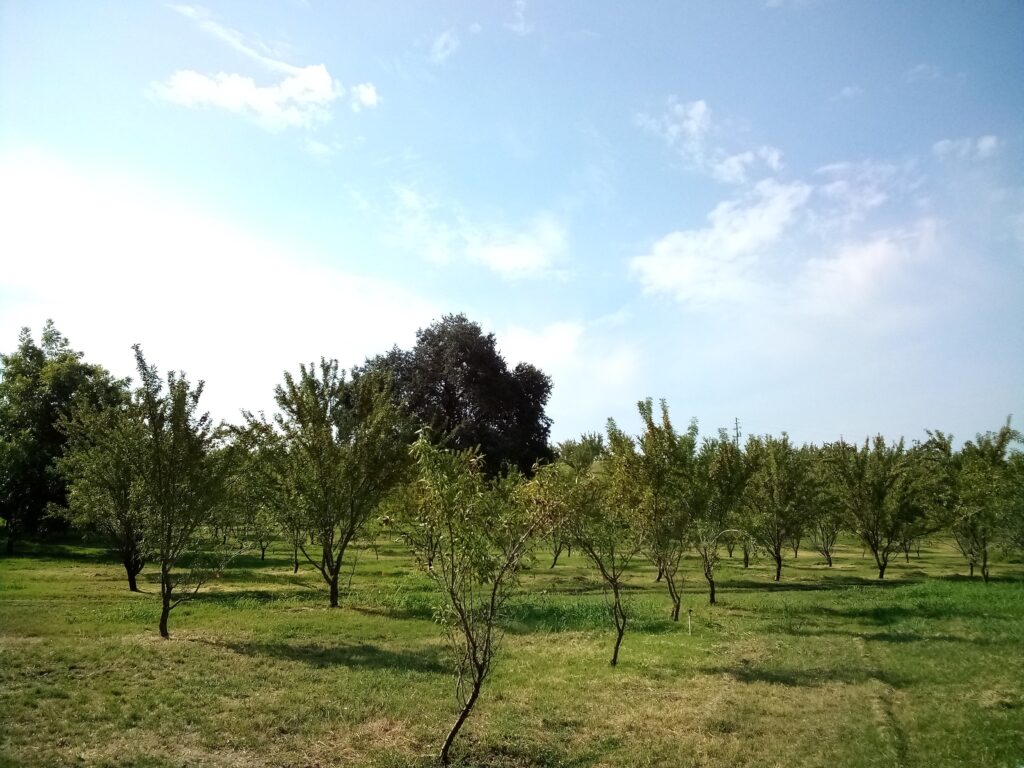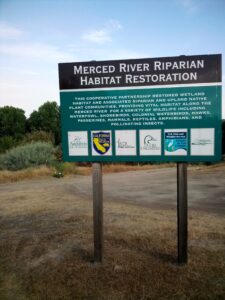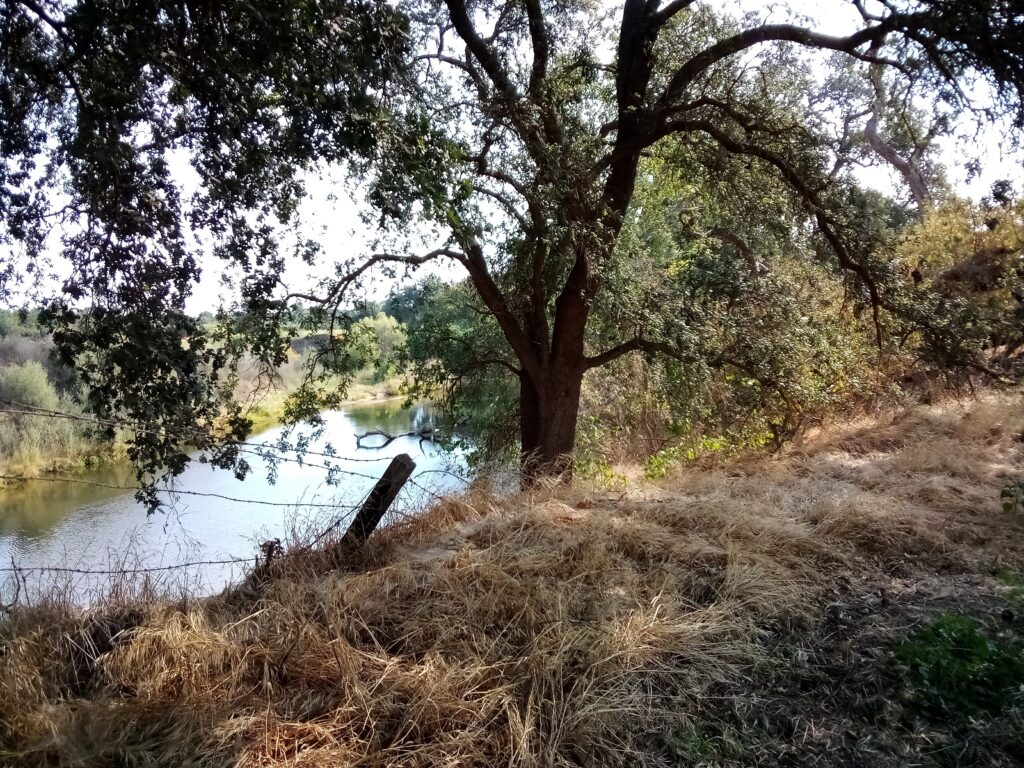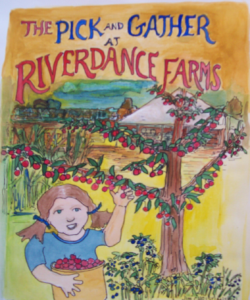AFT Approved for Funding to Protect Riverdance Farms in San Joaquin Valley
Along the scenic Merced River lies the picturesque 74-acre Riverdance Farms owned by Cindy Lashbrook and Bill Thompson. The organic family farm has become a cherished community spot for folks of all ages and cultures. The main crops are blueberries, walnuts, cherries, almonds, oat hay, and mini plantings of persimmons, pomegranates, pecans, and citrus. About 60 acres are farmable, while the remaining 14 acres have native riparian plantings along the river that begins at Yosemite Valley to the north.
AFT is helping to protect Riverdance Farms into perpetuity and spur valuable conservation in the rapidly growing Merced County, with the purchase of an agricultural conservation easement from the Lashbrook and Thompson families.
 This agricultural easement will be the second demonstration project of AFT’s San Joaquin Land and Water Strategy, which combines research, policy advocacy, agricultural land protection, and regenerative agricultural practices to protect the region’s farmland and dwindling water resources.
This agricultural easement will be the second demonstration project of AFT’s San Joaquin Land and Water Strategy, which combines research, policy advocacy, agricultural land protection, and regenerative agricultural practices to protect the region’s farmland and dwindling water resources.
Funds for Riverdance Farms easement were made available through the California Strategic Growth Council’s (SGC) Sustainable Agricultural Lands Conservation Program (SALC), administered by the Department of Conservation.
SALC is part of California Climate Investments, a statewide program that puts billions of Cap-and-Trade dollars to work reducing greenhouse gas emissions, strengthening the economy, and improving public health and the environment — particularly in disadvantaged communities.
“Riverdance Farms is exactly the type of productive, versatile, and resilient agricultural property that AFT wants to protect in the nation’s leading food-producing region,” explains Tom Stein, AFT’s California Regional Director. “The farm provides nutritious food, open space, and community services, while demonstrating regenerative agricultural practices that benefit human health and the planet.”
Agricultural Easements
For Cindy Lashbrook, getting an agricultural easement has been on her mind since the early 1990s. It was soon after she started her first organic farm and she was involved with Community Alliance for Family Farmers, Valley Land Alliance, and Farmland Working Group. When the family moved to the current riverfront location in 1996, the desire always remained.
“Riverdance is a special place, and we have visitors who come here to find peace in nature,” explains Cindy. “We wanted to protect it for the future. We need more rural communities, which are disappearing. My mom had an 88-acre farm in Illinois, and watching nearby areas get developed with housing developments and retail stores was discouraging. This small farm along the lower Merced River should always be open space that is growing healthy, diverse crops and being a haven for wildlife.”
Cindy became acquainted with AFT on a trip to Washington, D.C. with the sustainable agriculture community. Last January, she attended an AFT Women for the Land Learning Circle on Succession Planning and Land Access. During the event, she mentioned that she’d like to do an agricultural easement.
“Shortly afterwards Stacy Shutts at AFT contacted me,” says Cindy. “She has been very helpful with the required paperwork, and everything is going smoothly.”
 Regenerative Agricultural Practices
Regenerative Agricultural Practices
From the beginning, Riverdance Farms has been concerned about soil health, water issues, and wildlife. The farm composts and shreds tree branches to make mulch. They practice minimal tillage or no tillage, as much as possible. There is drip irrigation on berries, cherries, and vegetables. Between the almond trees, a winter annual cover crop is grown that helps control summer weed development, increases biodiversity, and conserves water.
 The farm also has diverse topography and growing conditions. “There are hills, native oak trees, and different types of light and soil on our farm. We focus on growing ‘the right plant for the right place.’ We don’t try to force plants to grow in conditions that won’t do well.”
The farm also has diverse topography and growing conditions. “There are hills, native oak trees, and different types of light and soil on our farm. We focus on growing ‘the right plant for the right place.’ We don’t try to force plants to grow in conditions that won’t do well.”
To encourage wildlife, they’ve planted additional riparian and native plants, hedgerows, and pollinator friendly flowers to encourage beneficial insects. The farm has wildlife corridors, as well as nesting boxes for owls, wood ducks, hawks, and bats.
“We’ve let lambsquarter grow, as the birds and coyotes like the seeds,” says Cindy. “They also eat my over-ripe persimmons, but if I haven’t picked them already, I figure it belongs to them.”
Riverdance Farm Customers
Along with their own farmstand, the farm sells to various customers.
“Part of our blueberries go to Veritable Vegetable, which is an women-owned and operated organic produce distributor based in San Francisco,” she explains. “Our nut crops go to commercial distributors of organic foods, but we keep some nuts here to sell. Some vegetables go to the East Indian community here, such as turnips, leeks, chives, and unusual crops.”
 The farm also has active U-pick business, which is popular among locals and Bay Area residents from India, Russia, or Asia. “This has been consistent since we started,” says Cindy. “The cultures seem to really care about fresh foods and seeing where it’s sourced. They want their kids to come to the farm and see nature.”
The farm also has active U-pick business, which is popular among locals and Bay Area residents from India, Russia, or Asia. “This has been consistent since we started,” says Cindy. “The cultures seem to really care about fresh foods and seeing where it’s sourced. They want their kids to come to the farm and see nature.”
Riverdance Pick and Gather Festival
Each year, Riverdance Farms hosts a Pick and Gather Festival that attracts about 1,200 folks for a weekend around Memorial Day. Folks can camp on the farm and fish. There are classes on food preserving and crafts. And, of course, plenty of U-Pick fruit opportunities.
 “The U-Pick helps fund the weekend event,” she says. “And the public has been very respectful around our farm. They haven’t broken branches or harmed plants. We’ve been able to meet in the middle between the land and the public’s enjoyment.”
“The U-Pick helps fund the weekend event,” she says. “And the public has been very respectful around our farm. They haven’t broken branches or harmed plants. We’ve been able to meet in the middle between the land and the public’s enjoyment.”
But the community’s love of the farm isn’t just limited to one weekend a year.
“People have always called and asked if they could visit,” recalls Cindy. “We have fishermen who help steward the land and keep me updated on the river. We have a preschool that comes thirty days a year and bases lessons around nature and life on the farm. We’ve even had fundraising dinners.”
But Cindy is quick to confirm they aren’t a venue. “We aren’t Farm Disneyland. This is a working farm with lots of nature stuff. We don’t have fancy porticos for a wedding or anything like that.”
Still, this farmer cherishes the connection to the community.
“If people didn’t come here, I wouldn’t have as much fun farming,” says Cindy. “I enjoy bringing people together with the land and the food by the river. Having this place to host people and hear their stories is very important to me.”
As she looks ahead at what awaits Riverdance, Cindy says cooperation will be key in the future for agriculture.
“Being a farmer is a challenge and a gift,” she says. “Much creativity and effort are needed to have a viable farm, and it’s difficult for family-scale farms to stay afloat. We all need to work together and steward our farmland and water resources. If we want this land to stay as farmland, the public needs to support these farmers. And if farmers work together, we can get the most out of the water available while sharing it with the population and wildlife. The future demands it.”

